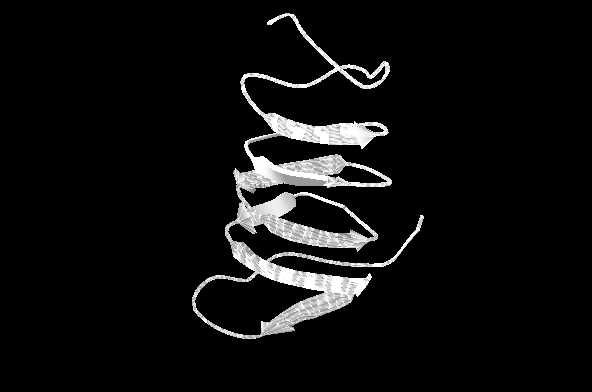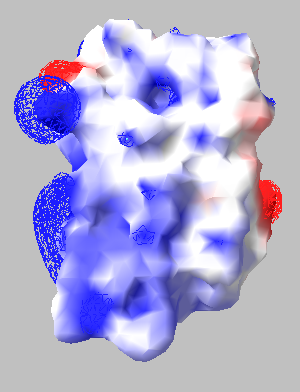From Proteopedia
proteopedia linkproteopedia link
| This Sandbox is Reserved from January 10, 2010, through April 10, 2011 for use in BCMB 307-Proteins course taught by Andrea Gorrell at the University of Northern British Columbia, Prince George, BC, Canada.
|
To get started:
- Click the edit this page tab at the top. Save the page after each step, then edit it again.
- Click the 3D button (when editing, above the wikitext box) to insert Jmol.
- show the Scene authoring tools, create a molecular scene, and save it. Copy the green link into the page.
- Add a description of your scene. Use the buttons above the wikitext box for bold, italics, links, headlines, etc.
More help: Help:Editing
|
Spruce Budworm Antifreeze Protein

Introduction
Spruce Budworm antifreeze protein is among a small but growing number of ice structuring proteins present in many cold-dwelling organisms including fish, plants, bacteria, and insects. As suggested by the name, this AFP is found in the Spruce Budworm insect with the highest concentration in the blood plasma and is significantly more active than those found in other organisms[1]. Tissue damage normally caused by mass organelle fracturing during the freezing process at sub-zero temperatures is avoided by the specific action of this unique antifreeze protein (AFPs), allowing survival at temperatures below the standard freezing range. AFPs are measured in their effectiveness to prevent ice crystal growth by the temperature difference between normal melting or freezing point, and the lowest temperature ice crystals remain absent, a phenomenon known as thermal hysteresis;Spruce Budworm is found in temperatures as low as -20° C [2].
Structure and Function

Electrostatic map of sbw AFP "TXT" motif ice binding surface displaying fairly regular charge spacing where ice crystal binds (blue indicates regions of positive charge)generated by Deepview molecular viewing software.
Spruce Budworm antifreeze protein is a member of the Beta-helix structural family. Monomeric in structure, it consists of a single polypeptide chain in a left handed coil that roughly approximates a triangular prism shape; 28 Å in height with 16-17 Å base sides. There are four disulphide bridges present and 15-17 amino acid residues per turn with 10 clearly identifiable beta sheets present in terms of secondary structure with a hydrophobic core
[3]. An ice binding face occurs on the side of the protein where four threonine-Xaa-threonine (TXT) motifs are stacked on top of eachother, X being an amino acid of no particular type
[4]. A highly geometric, regular pattern is formed by the threonine residues indicative of a likely crystal interaction site, suggesting strongly that the ice binding function relies on this precise structural character of the . It is thought that upon binding of early microscopic ice crystal nucleation sites, sbw AFP promotes the growing crystal to follow an energetically unfavourable crystallization pattern that follows a curve along the solid-liquid phase surface. Sbw AFP therefore does not prevent ice forming at 0°C, but instead limits crystal growth as to prevent catastrophic damage of the cell. Sbw AFP displays a slight change in structure as the protein is cooled according to NMR studies. Specifically, three groups of clustered amino acids (Leu11, Ser12, Phe42, Gly72, Ser77, Cys85, Phe87, and Ala89) showed large proton NMR chemical shifts at 5 degrees when compared to the 30 degree data, and all localize to the ice binding side of the protein
[4]. Temperature effected conformation change in Sbw AFP is therefore considered important in achieving the extremely precise and regular structural surface pattern required for ice crystal binding. N terminus residues form a tail that shows significant conformation heterogeneity between the temperatures 5°C and 30°C with X-ray diffraction data showing incongruities between two generated models.
References
- ↑ Graether SP, Kuiper MJ, Gagne SM, Walker VK, Jia Z, Sykes BD, Davies PL. Beta-helix structure and ice-binding properties of a hyperactive antifreeze protein from an insect. Nature. 2000 Jul 20;406(6793):325-8. PMID:10917537 doi:10.1038/35018610
- ↑ Yu SO, Brown A, Middleton AJ, Tomczak MM, Walker VK, Davies PL. Ice restructuring inhibition activities in antifreeze proteins with distinct differences in thermal hysteresis. Cryobiology. 2010 Dec;61(3):327-34. Epub 2010 Oct 25. PMID:20977900 doi:10.1016/j.cryobiol.2010.10.158
- ↑ Doucet D, Tyshenko MG, Kuiper MJ, Graether SP, Sykes BD, Daugulis AJ, Davies PL, Walker VK. Structure-function relationships in spruce budworm antifreeze protein revealed by isoform diversity. Eur J Biochem. 2000 Oct;267(19):6082-8. PMID:10998070
- ↑ 4.0 4.1 Graether SP, Gagne SM, Spyracopoulos L, Jia Z, Davies PL, Sykes BD. Spruce budworm antifreeze protein: changes in structure and dynamics at low temperature. J Mol Biol. 2003 Apr 11;327(5):1155-68. PMID:12662938


